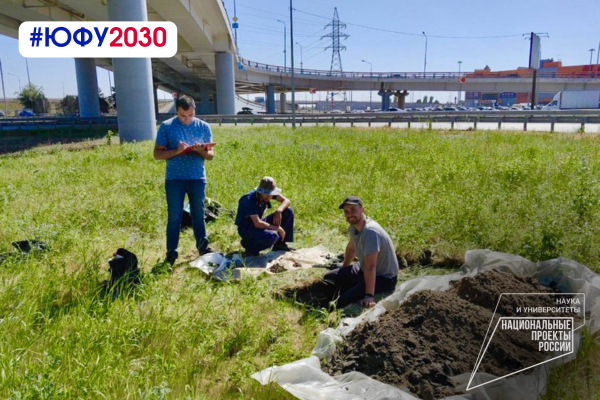
The implementation of the project "Studying the dynamics of carbon deposition of soil structures: from creation to sustainability", supported by the Russian Science Foundation, is coming to completion at the Academy of Biology and Biotechnology named after D.I. Ivanovsky Southern Federal University.
The southwestern part of the Rostov region is occupied by one of the most fertile soils in Russia — migration-segregation chernozems, or according to the classification of soils of the USSR — ordinary carbonate chernozems. However, on the territory of the city, in its residential and industrial areas, these powerful soils have either been destroyed or blocked by anthropogenic layers, which makes it necessary to carry out measures for their reclamation.
Sergey Gorbov, Head of the Scientific testing laboratory "Biogeochemistry", Professor of the Department of Botany at the Academy of Biology and Biotechnology, said that over the past 20 years, the process of replanting disturbed soils has become mandatory: these procedures are included in the regulations for urban landscaping.
"Any work on creating lawn coverings or planting flower beds on disturbed soils involves the creation of an artificial upper fertile layer. In fact, a significant proportion of the territory of roadside lanes, urban easements of squares and even parks is represented by new types of soils – replantozems or constructozems that perform the function of natural soils," said Sergey Gorbov.

During the field work, scientists have identified the power range of the reclamation horizons of Rostov-on-Don and established their maximum value. The thickness of the soil is its vertical extent, that is, the thickness from the surface deep into the poorly affected soil—forming processes of the parent rock.
"In the sample we studied, the range ranged from 10 to 35 cm, with an average value of 17 cm. But in our practice we have experience in the study of replanted soils with an introduced horizon thickness of more than 100 cm. At the same time, a lot does not always mean good: excessive power often leads to disruption of the intra—soil processes of movement of moisture and air in the root layer. Conditionally, it can be said that the optimal soil thickness for urban construction grounds is 15-20 cm. However, a lot depends on those cultivated plants that will grow there in the future," Sergey Gorbov shared.
A special distinguishing feature of regional constructozems is their binomiality: the profile of preserved chernozems often lies under urbanogenic horizons, with a slightly eroded surface humus-accumulative horizon. As a result, buried chernozem continues to evolve at almost all monitoring points under reclamation and urban horizons, providing additional nutrition to plants in the city.
To date, the question has remained open as to how these soils function over time, at what stages of their evolution in urban conditions, the stabilization of intra-soil processes of transformation of organic matter occurs and to what extent they are a serious source of carbon emissions, which is an important task on the way to carbon neutrality of urban ecosystems.

Regardless of the age of the recultivation horizons of the studied soils and the intensity of the anthropogenic load exerted on them, the content of gross organic carbon in Rostov design soils has similar values.
"Replanted soils of Rostov-on-Don are characterized by a stable state of soil organic carbon, they emit insignificant amounts of carbon dioxide in comparison with reclaimed soils of the northern regions of the country. This is due to the fact that the soils of agrogenic sites, which have been used for a long time in agricultural production, where humus is mainly represented by stable forms of carbon, serve as a source for the creation of structural soils. It can be stated that the newly created soil horizons are more characterized by changes in physical properties than chemical ones," explained Sergey Gorbov.
The study sample included urban soils of different ages from 2 to 17 years old on the basis of 12 monitoring points located in different parts of the city and a Soil hospital for the study of Structural soils localized in the Botanical Garden of the Southern Federal University. The selected monitoring points reflect the main options for reclaimed urban soils in the region.
Southern Federal University is a participant in the federal program "Priority 2030" (national project "Science and Universities"), implementing a number of projects, including those aimed at ensuring soil safety and fertility within the framework of the strategic project of the Southern Federal University "Soil Resource Management Systems".
Short link to this page sfedu.ru/news/76501




